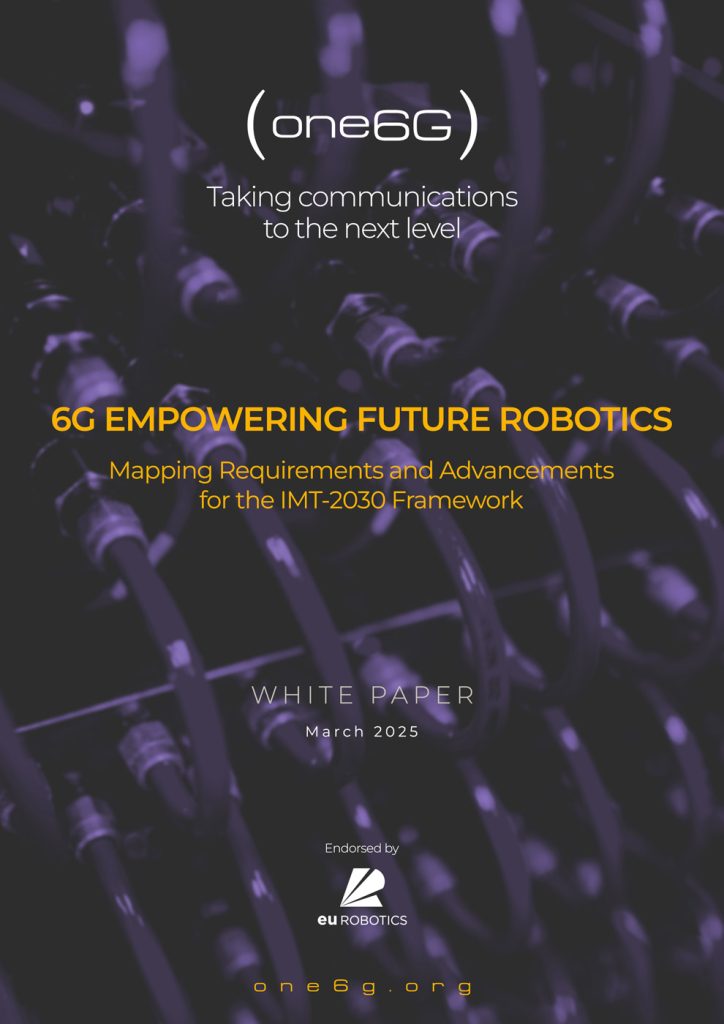one6G releases a White Paper “6G Empowering Future Robotics”
 The one6G Association just published a new White Paper exploring the transformative role of 6G in advancing robotic applications across various industries. As robotics adoption accelerates in sectors such as logistics, manufacturing, healthcare, and smart cities, the integration of advanced wireless sensing, communication, and AI-driven computational capabilities becomes increasingly critical. The White Paper, officially released at the European Robotics Forum Workshop #52 provides a comprehensive analysis of the technological innovations that 6G will introduce to support robotic applications.
The one6G Association just published a new White Paper exploring the transformative role of 6G in advancing robotic applications across various industries. As robotics adoption accelerates in sectors such as logistics, manufacturing, healthcare, and smart cities, the integration of advanced wireless sensing, communication, and AI-driven computational capabilities becomes increasingly critical. The White Paper, officially released at the European Robotics Forum Workshop #52 provides a comprehensive analysis of the technological innovations that 6G will introduce to support robotic applications.
Exploring Robotics and 6G Synergies
The White Paper builds on previous one6G publications, further examining the interplay between robotics and mobile communication technologies. It acknowledges the growing need for intelligent, interconnected robotic systems that can operate with higher reliability, efficiency, and autonomy while minimizing complexity and costs. By mapping robotic requirements to the expected capabilities of IMT-2030, the paper highlights key areas where 6G will enhance robotic functionalities.
Among the topics covered are:
- New and enhanced features: The paper investigates the features introduced by 6G that are crucial for enabling smart robotic applications.
- Enabling technologies: The paper identifies the essential elements required to meet stringent robotic requirements while exploring the reciprocal benefits that robotic technologies can bring to 6G network performance.
- 6G architecture and network impact: The paper assesses how the 6G network architecture will support seamless integration of sensing, computation, and control within mobile communication networks.
- Ethical and sustainability considerations: The paper discusses privacy, security, and ethical challenges associated with AI-driven robotic applications, emphasizing transparency, trustworthiness, safety, and sustainability as overarching principles of 6G-empowered future robotics.
- Standardization and multidisciplinary collaboration: The document examines the implications of AI models and techniques related to the processing of multimodal information gathered by robotic sensors, with a focus on privacy, ethical concerns, and sustainability issues as overarching IMT-2030 features.
Key Takeaways and Future Recommendations
As the transition from IMT-2020 (5G) to IMT-2030 (6G) unfolds, this White Paper emphasizes the need for continued research and investment in intelligent robotic systems. It provides key recommendations for stakeholders, including:
- Introducing new 6G-enabled features on-demand to enhance existing robotic services while maintaining cost efficiency.
- Strengthening global standards through organizations like 3GPP to drive economies of scale and support the development of next-generation robotics.
- Demonstrating the benefits of new communication protocols over IMT-2020 in terms of spectral efficiency, energy consumption, and cost-effectiveness.
- Investigating the commercial feasibility of extreme IMT-2030 requirements to ensure alignment with market needs.
Conclusions
The integration of 6G and robotics marks a crucial step toward more intelligent, efficient, and responsive autonomous systems. By aligning robotic advancements with next-generation wireless technologies, one6G’s latest White Paper sets the foundation for innovation across multiple sectors, from precision agriculture and healthcare to industrial automation and environmental monitoring. As research progresses, continued collaboration among industry leaders, researchers, and policymakers will be essential to ensuring that 6G-enabled robotics are sustainable, trustworthy, and beneficial to society at large.
For more details, access the full White Paper.
Endorsements and Industry Support
This White Paper includes the outcomes of the one6G Work Item 216 (6G Empowering Robotics) discussions. This paper has received endorsements from euRobotics aisbl, which recognizes its role in advancing the future of robotics and enhancing collaboration in the 6G and next generation wireless communication landscape. It also received the endorsement of the leadership members and participants of the IEEE SA 6G Empowering Robotics Working Group (IEEE P1955). Note: This endorsement solely represents the views of the IEEE P1955 Working Group and does not necessarily represent a position of either IEEE or the IEEE Standards Association.
